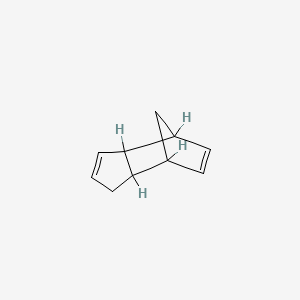

1. 77-73-6
2. Cyclopentadiene Dimer
3. Bicyclopentadiene
4. Biscyclopentadiene
5. Dicyklopentadien
6. Dimer Cyklopentadienu
7. 4,7-methano-1h-indene, 3a,4,7,7a-tetrahydro-
8. Dcpd
9. 3a,4,7,7a-tetrahydro-4,7-methanoindene
10. 3a,4,7,7a-tetrahydro-1h-4,7-methanoindene
11. Nsc 7352
12. 4,7-methanoindene, 3a,4,7,7a-tetrahydro-
13. 4,7-methano-3a,4,7,7a-tetrahydroindene
14. 4,7-methano-1h-indene, 3a,4,7,7a-tetrahydro-, Homopolymer
15. Chebi:34695
16. Endo-dicyclopentadiene
17. 25038-78-2
18. Prometa Xp 100
19. Ncgc00090776-02
20. Tricyclo[5.2.1.02,6]deca-3,8-diene
21. Tricyclo[5.2.1.0(2,6)]deca-3,8-diene
22. Dicyklopentadien [czech]
23. Dimer Cyklopentadienu [czech]
24. Ccris 4790
25. Hsdb 321
26. 1,3-cpd
27. 3a,4,7,7a-tetrahydro-4,7-methano-1h-indene
28. 1755-01-7
29. Alpha-dicyclopentadiene (endo Form)
30. Einecs 201-052-9
31. Un2048
32. Tricyclo(5.2.1.0)-3,8-decadiene
33. Dicyclopentadiene Homopolymer
34. Brn 1904092
35. Nsc-7352
36. Ai3-03386
37. Un 2048
38. 1, Dimer
39. Tricyclo[5.2.1.0<2,6>]deca-3,8-diene
40. Dsstox_cid_5023
41. Ec 201-052-9
42. Dsstox_rid_77632
43. Dsstox_gsid_25023
44. 2-05-00-00391 (beilstein Handbook Reference)
45. Mls001055376
46. Chembl1570502
47. Dtxsid5025023
48. Nsc7352
49. (3a.alpha.,4.alpha.,7.alpha.,7a.alpha.)-3a,4,7,7a-tetrahydro-4,7-methano-1h-indene
50. Hms3039j06
51. Wln: L C555 A Du Iutj
52. 933-60-8
53. Tox21_400017
54. Stl445669
55. Akos000119974
56. Akos022186108
57. 3a,7,7a-tetrahydro-4,7-methanoindene
58. 4,7-methano-1h-indene, 3a,4,7,7a-tetrahydro-, (3a.alpha.,4.alpha.,7.alpha.,7a.alpha.)-
59. Cas-77-73-6
60. Ncgc00090776-01
61. Ncgc00090776-03
62. Ac-16096
63. Smr000677942
64. Dicyclopentadiene Contains Bht As Stabilizer
65. D0443
66. Dicyclopentadiene [un2048] [flammable Liquid]
67. Q419053
68. J-520256
69. Q-200967
70. F0001-1975
| Molecular Weight | 132.20 g/mol |
|---|---|
| Molecular Formula | C10H12 |
| XLogP3 | 2.5 |
| Hydrogen Bond Donor Count | 0 |
| Hydrogen Bond Acceptor Count | 0 |
| Rotatable Bond Count | 0 |
| Exact Mass | 132.093900383 g/mol |
| Monoisotopic Mass | 132.093900383 g/mol |
| Topological Polar Surface Area | 0 Ų |
| Heavy Atom Count | 10 |
| Formal Charge | 0 |
| Complexity | 212 |
| Isotope Atom Count | 0 |
| Defined Atom Stereocenter Count | 0 |
| Undefined Atom Stereocenter Count | 4 |
| Defined Bond Stereocenter Count | 0 |
| Undefined Bond Stereocenter Count | 0 |
| Covalently Bonded Unit Count | 1 |
In general, although some dicyclopentadiene can be exhaled unchanged, most of that absorbed is hydroxylated in the liver, undergoes glucuronide conjugation, and is excreted in the urine.
Bingham, E.; Cohrssen, B.; Powell, C.H.; Patty's Toxicology Volumes 1-9 5th ed. John Wiley & Sons. New York, N.Y. (2001)., p. V2 39
/MILK/ When given by oral administration to lactating cows urine and feces contained 86% of administered dose with only trace amounts being secreted in milk. Some may have been eliminated in gaseous form. Compound was extensively absorbed from GI tract.
PMID:7459454 Wayne G, Oehler DD; Bull Environ Contam Toxicol 24 (5): 662-70 (1980)
Dicyclopentadiene is predicted to be rapidly absorbed and distributed following any route of administration. It is extensively absorbed from the GI tract.
Bingham, E.; Cohrssen, B.; Powell, C.H.; Patty's Toxicology Volumes 1-9 5th ed. John Wiley & Sons. New York, N.Y. (2001)., p. V4 203
The substance can be absorbed into the body by inhalation and by ingestion.
IPCS, CEC; International Chemical Safety Card on Dicyclopentadiene. (October 2005). Available from, as of October 03, 2006: https://www.inchem.org/documents/icsc/icsc/eics0873.htm
Tetramethylenephosphonate derivatives of norborane (TPNB) and dicyclopentadiene (TPDCPD) were shown to readily form stable chelates with (99m)Tc that had high and selective bone uptake. The skeletal uptake and blood clearance properties of (99m)Tc-TPNB were similar to (99m)Tc-MDP in both rats and rabbits. This suggests additional studies to further evaluate (99m)Tc-TPNB or perhaps other large-organic based multidentate phosphonate ligands as potential bone imaging agents is warranted.
PMID:3771236 Volkert WA et al; Int J Rad Appl Instrum B 13 (1): 31-7 (1986)
When given by oral admin to lactating cows, metabolites were present in urine mainly in form of glucuronide conjugates. It is suggested that epoxidation of double bonds occurred, followed by hydrolysis of epoxides to diols & conjugation with glucuronic acid.
Wayne G, Oehler DD; Bull Environ Contam Toxicol 24 (5): 662-70 (1980)
... Urinary metabolites of dicyclopentadiene were not identified specifically, but analysis by thin layer chromatography indicated that the urine of mice and rats each had seven components. Six components were found in the urine of dogs. The Rf values of these components were similar; therefore, common metabolites were indicated in all three species. Only 1-3% of the radioactivity was attributed to nonmetabolized (14)carbon-dicyclopentadiene in all three species. When the urine from all species was subjected to enzymatic hydrolysis by glusulase (beta glucuronidase and sulfatase) and extracted, was recovered in the extract, indicating the presence of urine conjugates.
USEPA; Health and Environmental Effects Profile for Cyclopentadiene and Dicyclopentadiene p.16 (1987) ECAO-CIN-G012